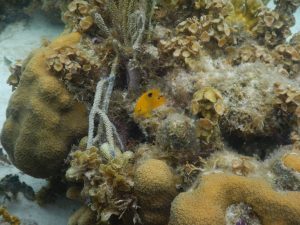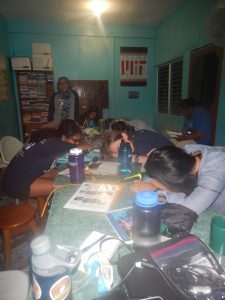Today we collected some data to assess the current state of the coral reefs around Middle Caye Island in Glover’s Reef. We measured coral cover on the benthos (sea floor) of both marine protected areas and non-protected areas using our quadrats that we made yesterday and transect tape. We haven’t analyzed our data yet, but I’m hoping that at least the marine protected areas at least maintain the healthy baseline coverage of at least 10% coral coverage.
Right after lunch, we visited a coral graveyard. It contained a large pile of fossilized coral skeletons that are millions of years old, probably. We tried to identify different types of coral, the most of which I remember is brain coral, due to its obvious resemblance to a human brain. The structures were absolutely beautiful, and it helped us familiarize ourselves with the structures we might encounter on the reef.
On a more personal note, I learned how to properly prepare and wear my mask so that the sea water didn’t get into my eyes. Therefore, I was able to see EVERYTHING underwater. Unfortunately, my camera isn’t working at the moment, but once I resolve this issue I will try to update this post with pictures of some of the herbivorous fish I saw during this activity, including parrotfish and six individual four spotted butterfly fish. Some of the other animals we saw were teeny tiny jellyfish that may or may not have stung Kristen in the head, a moray spotted eel and, this may come as a shocker, many, many coral of many different colors such as yellow, purple and red. Seeing coral reefs a foot in front of you is an absolutely surreal experience, and a description in words cannot bring this experience to justice.


After dinner I gave a presentation on the threats to coral reefs. I talked about how global warming, overfishing, ocean acidification and hurricane-strength storms are all contributing to the rapid decline of coral reefs. In fact, many marine biologists agree that most coral reef systems will experience rapid decline and even extinction within the next 30-100 years. It occurred to me while snorkeling that I am really fortunate to be able to see that majesty that is the coral reef ecosystem because they might not be around in a few generations. I posted an infographic if anyone wants to know a little bit more about what you can do to help protect this ecosystem.


Credit: oceanservice.noaa.gov
